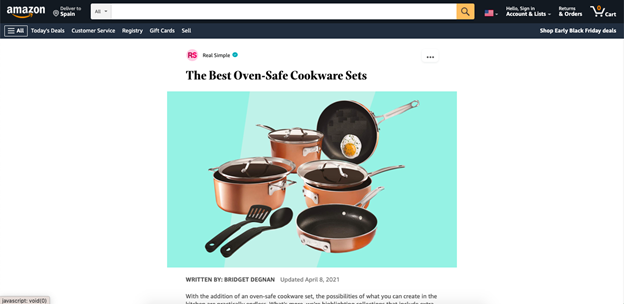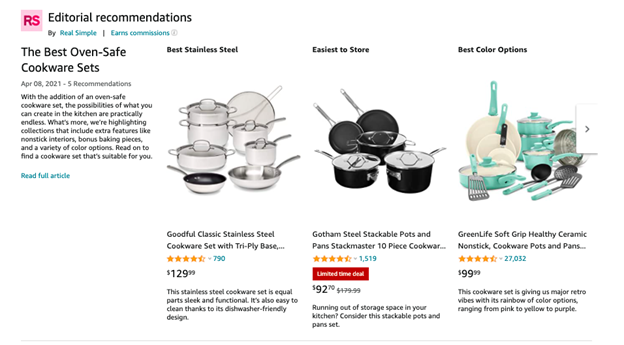They’re essentially a more ‘independent’ validation of a product than the Amazon Choice badge and scoring an editorial recommendation can be a major boom for business. If you’re interested in what Amazon editorial recommendations are and how they work, there are a few key details you’ll need to understand. Especially if it’s something you’re considering for your business.
What Are Amazon Editorial Recommendations?
We’ve all gotten used to Amazon’s top rated, best seller, and Amazon’s Choice labels and badges but the next step: Amazon editorial recommendations. Search a given keyword, say “headsets” or “nonstick pots and pans”, scroll down four or five rows, and you’ll find editorial recommendations for products within the category you’re searching. The recommendation comes in the form of an article written by an outside source, called a publisher or content creator, that aren’t directly affiliated with Amazon or the brands selling on Amazon.
If you click on “read full article,” it will open a link to the article on Amazon (not on the publisher’s own website) where you can read about their reviews and recommendations for the given products. The editorial recommendations has a highly visible placement within the SERP, taking up the entire 3rd or 4th row where products would normally be found. The idea behind it is that a person, not an algorithm, is giving their honest review about the best products for a specific search. In this case, nonstick pots and pans.
However keep in mind that while recommendations are written by third-party publishers, it’s Amazon that chooses which reviews get placed on the search results page for a given keyword.
Who Writes Amazon Editorial Recommendations?
The publishers that write Amazon editorial recommendations are major names that have been invited by Amazon to join their Onsite Associates Program. Yes, it’s as exclusive as it sounds and it’s part of the reason why editorial recommendations seem like such an exclusive world. If you go back to any given editorial recommendation on Amazon, you may also notice a small link under the editorial recommendation’s header titled “earns commission.”
This opens another tab with information about the Onsite Associates Program. What’s important here is that this program is by invite only, and onsite associates are eligible to earn a commission for every qualified purchase. So how do they get invited? Generally, these content creators need to have a major following, the ability to influence sales, and be an expert in their niche. Think Forbes, BabyCenter, Good Housekeeping, and Wirecutter.
But a write-up from them means your product gets exposure on the first page of an organic Amazon search and (more often than not) on their website. Additionally, since these are major publishers within their niche, customers can trust that they have a credible take on the product.
What Products Qualify for an Amazon Editorial Recommendation?
The first, and most important thing to note, is that editorial recommendations are not for beginners. You need to have a proven track record of sales, great Amazon reviews, and sufficient inventory. So if that’s not you, then an Amazon editorial recommendation isn’t in the cards…right now. But you’ll still want to read on to see how it might work for your business in the future. Or how it’s currently working for your competitors.
In general, products eligible for an Amazon editorial recommendation must:
- Have a 3.8+ star (some sources say 4+ star) product rating
Amazon isn’t going to waste space on products with low ratings. Customers need to know that editorial recommendations are reserved for high-quality products.
- Have 100+ Amazon reviews
Likewise, this is about customer trust, sales, and experience. Customers will want assurances that products reviewed in the editorial recommendation box work (and work well) based on what other customers have to say about it.
- Have Page 1 Organic Ranking
More proof that this program isn’t for novice sellers but is geared towards businesses with a proven track record.
- Have high inventory
Getting an editorial recommendation is meant to be a boost in sales. High inventory means you’re ready for that rush, which ultimately leads to better reviews and better ratings.
- Be part of an approved category
Products that involve medical claims, sex, drugs, or religion are typically left out of the editorial recommendation pool. Have you checked all those boxes? Then you’re ready for the next step.
How Do You Get an Amazon Editorial Recommendation?
There are two routes to getting an Amazon editorial recommendation: organically or through an agency. Notice that you can’t get an editorial recommendation through Amazon. The company has no part in what products publishers choose to promote or what keywords they’ve chosen to write about. The only way to get your product reviewed is to get noticed by a third-party publisher—whether that happens on its own or thanks to an agency you’ve hired.
Through an Agency
Agencies have proven to be the gatekeepers and bridges between Amazon sellers and publishers. There are two reasons for that. First, onsite publishers are seen as an exclusive club that’s very difficult to tap. Second, there are so many products on Amazon that it can be difficult for publishers to cut through the fluff.
Agencies meet both of those needs. They help sellers by having a network of contacts in place and they help publishers by providing them with a selection of top-notch products that have already been vetted. If you’re going to go through an agency, you can expect the following procedure.
Step #1: Research
Find an agency that works with big-name publishers, determine what their eligibility criteria is for Amazon sellers, and what their fees are.
Step #2: Make Sure You Meet Their Criteria
We’ve already gone over what Amazon looks for, but each agency may have more stringent requirements. For example, most agencies won’t take on your product unless it ranks for a certain category or keyword.
Step #3: Vetting
Contact the agency and provide your product information, stats, and potential keywords. Agencies need to make sure that the products they send to publishers are the real deal. So they’ll vet your product first to determine whether it’ll be worthwhile for content creators and Amazon.
Step #4: Wait for Publishers
Now it’s the agency’s job to put your product in front of publishers in your niche. This step can take up to a few weeks, while content creators determine if they’re interested in your product.
Step #5: Wait for Amazon’s Decision
Once your editorial recommendation is written, it will be submitted to Amazon. Like we mentioned earlier, it’s Amazon who decides to accept it or not.
Step #6: Pay the Agency
Agency fees vary. You may be expected to pay one lump sum or a monthly fee. Keep in mind, some companies won’t charge you if your editorial recommendation wasn’t accepted by Amazon or if you don’t make any money from the recommendation.
The Pros and Cons of Going With an Agency
Agencies have, so far, proven to be the gatekeepers to an editorial recommendation. They have the contacts, the expertise, and the means to get your product in front of content creators’ noses. However, you’ll need to decide if the profit margin for your product is large enough to cover potential agency fees.
Organically
The alternative is letting your product be picked up by a content creator organically. This can happen because you’ve reached out to onsite associate publishers on your own or they’ve found your product themselves. Additionally, while it looks like it’s in the beta stages for now, Amazon is paving the way for sellers to contact publishers directly via a “creator connections” option. Stay tuned as this evolves.

Until then, however, the procedure to get your products featured in editorial recommendations organically are to:
Step #1: Offer a Quality Product
Yes, this can be said for the agency method as well, but it’s even more important if you don’t have an agency putting your product in front of potential publishers. Your products need to stand out via sales, reviews, and rankings to get noticed by content creators.
Step #2: Promote Your Brand
Social media marketing, advertising campaigns, word of mouth, you name it. Get your product out there. There’s no other way you’ll get to step three without it.
Step #3: Meet Amazon’s Requirements
A quality product plus promotion gives you the best chance of meeting the eligibility criteria that Amazon and publishers look for when deciding who gets an editorial recommendation.
Step #4: Contact Publishers
Since you won’t have an agency to do this for you, you’ll be the one cold calling onsite associate publishers via LinkedIn, Facebook, email, etc.
Step #5: Let Amazon Do Its Thing
You’ve done the legwork, a publisher has written a recommendation on your product, now it’s time to let Amazon decide whether to use it or not.
The Pros and Cons of Getting an Organic Editorial Recommendation
Since you won’t have to pay any agency fees, it’s pretty darn cost effective. However, and this is a big one, it’s also extremely difficult to crack the editorial recommendation world this way. You may put in a lot of time and energy with little to no results. Note: it will be interesting to see how the content connections beta pans out and if it opens the doors for sellers to get better access to editorial recommendations.
What Are the Benefits of Amazon Editorial Recommendations?
It’s not hard to see why sellers are eager to get an editorial recommendation. Yes, it’s a somewhat secretive and elusive method of advertising, but it provides results for the lucky ecommerce brands vying for customer attention. While the success rate varies from brand to brand, the benefits of Amazon editorial recommendations are many.
They Boost Page Visibility
Getting your product on the first page of an organic search is key. Additionally, since editorial recommendations are visibly larger, they’ll stand out to customers and increase the likelihood of your product getting clicked on.
They Validate Your Brand
An authority in your niche, writing about your product, is the social proof you need to validate your business. Plus, because Amazon has such high standards for its editorial recommendations, it makes it easy for customers who don’t want to scroll through dozens of low-quality, knock-off duds.
They Gain Customer Trust
Why? Because your recommendation is coming from an actual customer (or writer of a major publication) and not directly from you, the seller. Customers don’t want to hear a whole sales spiel, but they do want to know—from a friendly and reliable source—what works.
They’re Cost Effective
This depends somewhat on agency fees (if you go that route), but editorial recommendations can be far cheaper than shelling out money on other advertising methods.
They Give You Double Exposure
Not only will your product be featured on an editorial recommendation, but publishers will often run the Amazon review on their own websites. And these are big hitters in their niches with large audiences.
Increased Sales
Finally, the whole point is to increase sales. Editorial recommendations get more exposure, more clicks, and more chances for customers to buy your product.
Where Do Amazon Editorial Recommendations Go From Here?
Amazon is constantly evolving in an attempt to get businesses noticed and products sold. So, while editorial recommendations are a major boon for businesses, it’s worth noting that these policies are always changing.
As an ecommerce brand, you may have chased the Amazon Choice badge before it got inundated with low-quality products. Editorial recommendations are a way to rectify that. Instead of a computer algorithm determining who gets to be an Amazon Choice, real people are testing out products and giving customers their honest opinions.
Now, with the potential for sellers to get in touch directly with publishers, we’re looking at a new era of accessibility for editorial recommendations and an easier way for customers to see the best product for their needs.
